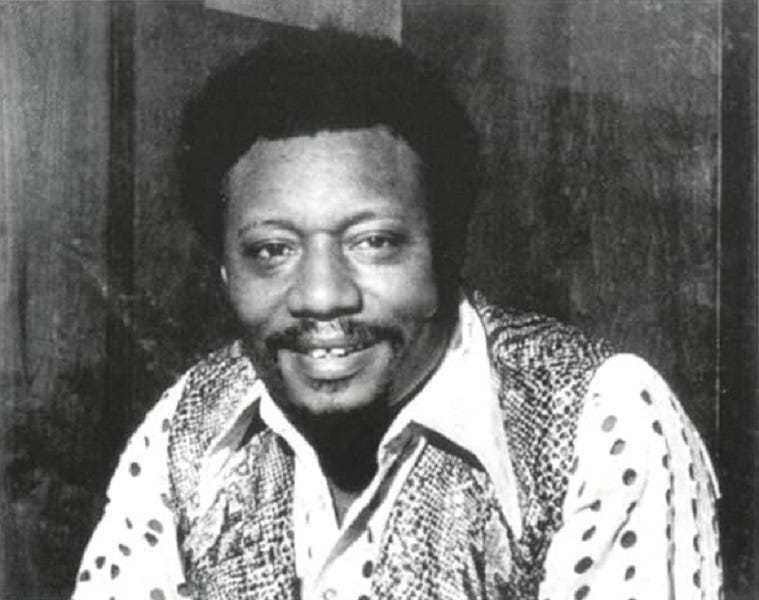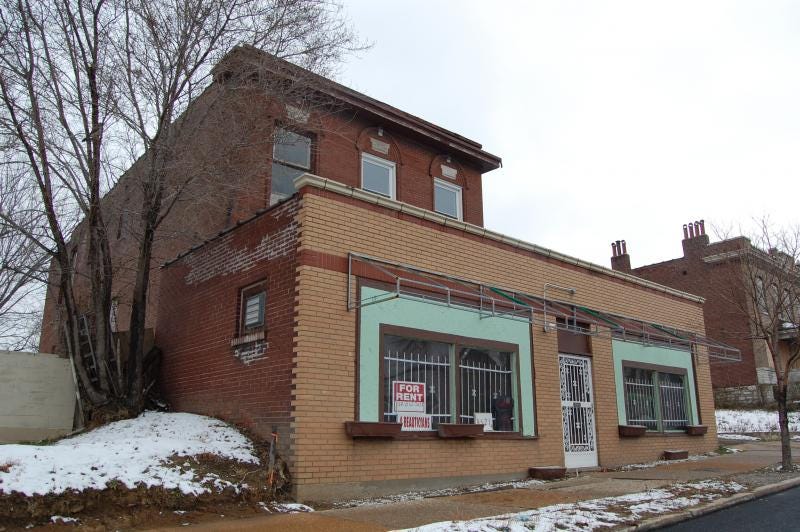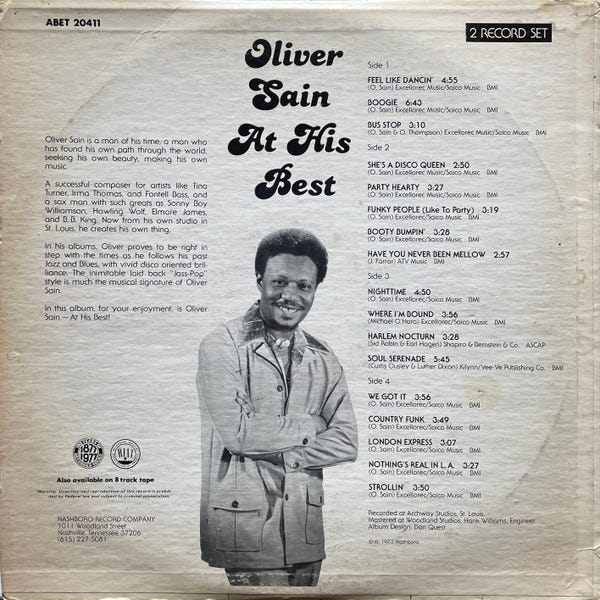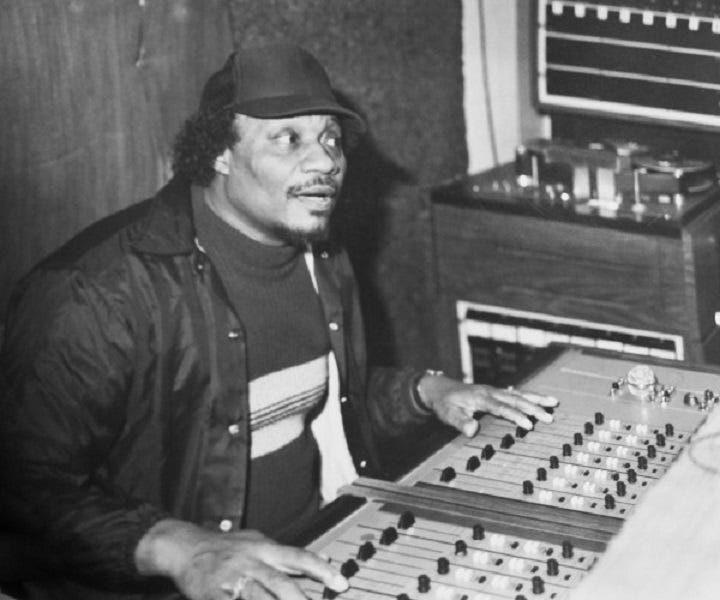Oliver Sain (March 1, 1932 – October 28, 2003) – Who You Gonna Blame (1972)
The unsung songwriter and producer wrote this gospel-flavored, socially conscious jam for Fontella Bass' second album, who he had discovered a decade earlier.
View most updated version of this post on Substack
Open YouTube playlist of all songs
Search our full archives
Oliver Sain was a multi-instrumentalist, songwriter and producer. He was Little Milton’s bandleader in the early 1960s when he discovered Fontella Bass, and subsequently wrote and produced many songs for her. Sain set up his own studio in St. Louis where he recorded for three decades, releasing a handful of solo albums and producing other artists.
Born and raised in the Mississippi Delta, as a child he learned to play trumpet and taught himself the drums. He moved to Greenville, MS in 1949 to become the drummer for a group led by blues harmonica player Sonny Boy Williamson, in which Sain’s stepfather Willie Love played piano. He then spent several years drumming for Howlin’ Wolf, and relocated to Chicago in 1955.
He served in the Korean War before returning to Greenville to rejoin his stepfather as part of Little Milton’s backing band. By this point he had started playing saxophone.
Sain eventually took over as Milton’s musical director. When they traveled to East St. Louis to play the Manhattan Club for a weekend gig, he was impressed with the city’s music scene and decided to move there. He continued working as Little Milton’s bandleader, and after hiring a keyboard player named Fontella Bass discovered she had an amazing voice.
When he left Little Milton a few years later, Bass came with him and became the co-lead singer along with Bobby McClure in his Oliver Sain Soul Revue. Sain co-wrote and co-produced McClure’s 1965 debut single, “I’m Not Ashamed” b/w the superb jam “I'll Be True To You.”
In 1965 he wrote and produced a hit song for Bass and McClure called “Don’t Mess Up a Good Thing.” It went to #5 R&B and #33 on the Billboard Hot 100, helping launch both their careers. The same year, Sain opened his own recording facility in St. Louis, Archway Sound Studio. He used his first royalty check from “Don’t Mess Up a Good Thing” to buy the studio’s soundboard and a 16-track tape machine. Ike and Tina Turner were among the artists who came to St. Louis to record there.
At Archway, Sain began writing and producing at a furious pace for Bass, McClure, and other artists. In 1967, he produced a new version of “I’m Not Ashamed” for the Soul Blenders with the Oliver Sain Orchestra, b/w the upbeat funky jam “The Deal,” written by William Drain. The same year, he produced their single “Beautiful Illusion,” co-written by Drain and guitarist Phil Westmoreland, and its stellar B-side “Love Built On A Strong Foundation” which he wrote. Original copies today sell for $200 on average on Discogs.
Sain wrote both songs that Ann Peebles released as her first single on Hi Records in 1969, co-produced by Willie Mitchell (who coincidentally was also born on March 1), the heartfelt “Walk Away” b/w the superb “I Can’t Let You Go.” He wrote the upbeat soul/funk jam “Try My Love” (1972) for Jamie Ross, which was released on T.K. Records sub-label Cat and credited to DAJ Productions.
In 1972, Sain produced Fontella Bass’ second solo album, after she and her husband Lester Bowie had spent two years living in Paris. She and Sain co-wrote the beautiful opening cut “To Be Free.” Sain wrote two other songs, including the album’s single, the gospel-flavored, socially conscious jam “Who You Gonna Blame.”
“Our brothers have gone a million miles to free somebody else, when they've been here all the time, and they ain't free themselves….I'm so tired of this cryin', I'm so tired of this dyin'.”
Its B-side was “Hold On This Time,” co-written by Don Davis, Homer Banks and Raymond Jackson.
Sain released his first solo album Main Man in 1972. He produced, arranged, engineered and recorded it, and played alto and tenor saxophone, organ, and vibraphone. Paul Jackson was featured on bass, who would shortly rocket to fame in Herbie Hancock’s Headhunters.
Standout cuts were the laid back soul-jazz jam “Comin Down Soul,” and the epic laid back jam “On The Hill,” both of which Sain wrote. The latter has been sampled by multiple hip hop artists beginning in the nineties including Pete Rock and C.L. Smooth.
Main Man came out on Abet Records, the R&B subsidiary of gospel label Nashboro Records. Sain would put out another three albums on Abet over the next five years. His second LP was Bus Stop (1974). It was packed with great cuts, starting with the funky soul-jazz title track, the sexy jam “Blowing For Love,” the very funky “Booty Bumpin' (The Double Bump),” the epic beautiful “Nighttime,” and the superb, hypnotic jam “California Sunset.”
His third album Blue Max (1975) finally gave him a hit as a solo artist when his party jam “Party Hearty” hit #16 R&B. Its B-side was the funky jam “She’s A Disco Queen,” dominated by one of Sain’s relentlessly grooving sax solos. “She’s A Disco Queen” was itself issued as an A-side in the UK and Japan, with the super funky self-empowerment anthem “Get Up And Hustle” on the flip with a line that should have made it onto a 70s motivational poster - “Nothing comes to sleeople but a damn good dream!”
In 1977, Abet released a double album greatest hits compilation of his previous works titled Oliver Sain At His Best. It also included a half-dozen newly recorded tracks. The superb funky jam “Nothing's Real In L.A.” was issued as a single, written and produced by Sain.
Another highlight was the disco-funk workout “Funky People (Like To Party).” Sain’s disco anthem “B-OO-G-IE” was released as a 12” single.
The masterpiece of the newly recorded material was arguably the superb funk jam “We Got It.”
Sain released his final solo album in 1981. It was issued on the independent HCRC label (Houston Connection Recording Corporation), distributed by CBS, and was one of that label’s first-ever releases. The LP’s spaced-out jazz-funk instrumental closing cut was “Space Dance,” co-written by Sain with Cameo founder Larry Blackmon, who also played rhythm guitar on the track.
Unfortunately, following Sain’s death in 2003, his widow Ruby was unsuccessful in her efforts to transform Archway Sound Studio into a museum or education center for young musicians. The building stood vacant for a decade before being damaged by vandals in 2014, and was demolished a few years later, a tragic end to an unheralded but important part of St. Louis and American music history.
Happy Heavenly Birthday to the great Oliver Sain.
Further info:
“Soul Reunion keeps Oliver Sain's soul alive,” St. Louis Beacon, October 21, 2008.
“Oliver Sain's Archway Sound Studio,” by Mark Overton, Saxophone.org, April 20, 2012.
“Oliver Sain’s recording studio ransacked by copper thieves,” KTVI, November 13, 2014.
“St. Louis loses another cherished cultural symbol,” by Bernie Hayes, St. Louis American, August 7, 2019.
#soul #jazz #funk #disco #OliverSain







